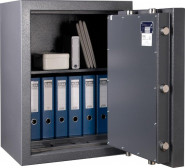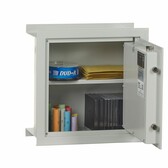While it is seemingly not so simple to choose wrong when selecting a home safe, there are many levels on which it is easy to make a mistake. There are plenty of home safes to choose from, they vary in terms of both the class of safe, size, level of fire safety and so on, hence today we will suggest not as much how to choose a good home safe, but how to choose the perfect safe just for you. A safe is a device that will accompany you for many years, and to which you will entrust your most precious belongings, items of particular, but not always financial value, documents. It can also be used to store weapons. In a word, the home safe is a personal piece of equipment that must be individually adapted to your needs.
What is a home safe used for?
Before we focus on the choice of a safe, let us try to define what a safe is. In simple terms, a home safe is a box made mostly of steel with a steel door, whose security is provided by a multi-point locking mechanism and a lock, which is usually an electronic lock.
The level of security provided by a given home safe is defined by its security class. There are quite a few classes, and choosing a safe will mostly just come down to determining its resistance. For example, if you need a safe for storing weapons, ammunition and nothing else, you may only need an S1 class, which is the lowest available, but sufficient under the law. Burglar-proof class II, in turn, is suitable for storing money, valuables, jewellery or other valuables. For storing documents, it is worth investing in a fire-resistant model.
Security classes
As I mentioned, there are several classes that define the level of security of a safe, both in case of burglary and fire. In order from the weakest to the best, they are as follows:
• S1, S2 – basic resistance classes according to EN 14450, most often we have a light home safe, a furniture safe in these classes, not for storing cash or valuables rather but for housekeeping purposes. Safes in these classes find buyers among offices and other units where there is a requirement to have a safe, while the risk of burglary is minimal. Home safes in these classes protect the contents from falling into the wrong hands.
• 0, I, II, III, IV and V – resistance classes for safes designed to emerge unscathed from a burglary attempt using serious equipment. The security class here is based on the stricter EN 1143-1 standard.
Fire resistance
S60P/S120P – fire resistance level expressed in minutes, 60 and 120 minutes respectively, certified in accordance with the EN 1047-1 standard.
You can read more about resistance classes in the Security tab, as well as in the article: Security levels of safes – what do the burglary resistance classes of safes mean in practice?
What types of home safes are there?
Home safes can come in different forms.
• furniture home safes: this is a category of home safes whose size and weight allow them to be placed in a built-in piece of furniture. Keep in mind that even when placed in a piece of furniture, the safe must be permanently mounted to the wall or floor.
• wall safes: when choosing wall-mounted models, customers are most often motivated by the desire to hide the safe from view. There is something to it if such a safe is to be used for storing documents, smaller amounts of cash or handy items. We recommend that more valuable documents or family heirlooms are kept in heavier models that offer more effective protection.
• burglar-proof safes: these are the best home safes in our range. The individual models obviously differ from each other in both size and class, but if you want to store valuables, securities, important documents or even a little bit of data media safely, then it is definitely worth choosing a home safe from this category.
Locking options
Every home safe comes with a key lock as standard. This solution, although simple, intuitive and inexpensive, is not optimal and the vast majority of our customers opt for an electronic lock.
Electronic locks are very easy to operate. The individual models differ slightly, but using an electronic lock is no trouble at all. All you have to do is enter the code on the keypad, usually a 6-digit number, and pull the handle. The batteries can usually be changed without opening the safe and the whole procedure literally takes a few moments.
A half-way solution is mechanical combination locks, i.e. the good old dial. A mechanical lock may appeal, especially to customers who are not keen on electronics as such. Remember, however, that a mechanical lock requires precision and patience.
Security and lock type
The type of lock does not directly affect the level of burglary resistance. If you buy a safe with a key lock, you have to reckon more with the inconvenience of keeping track of the keys. Electronic locks are much more convenient than using a safe with a key.
A safe at home is usually used by several people, the adults in the household. The absence of a physical key minimises the possibility of children getting into the safe, and here it is not even a question of our children pilfering our valuable jewellery. If the safe is used to store weapons, then security is a priority.
On the other hand, if this risk is eliminated, you can choose an electronic lock with an emergency key for the safe at home as an additional security measure. This double lock can work on a four-eye principle: you need both a key and a code to open the safe, or on an emergency basis – you use the key when the electronic lock fails.
Mounting
When choosing a home safe, it is important to consider the location of the safe. Not every location is suitable for fitting a safe – several conditions must be met in order for a place to be suitable:
• first of all, check the dimensions,
• a home safe, even a small one, can weigh a lot, so make sure the chosen location can withstand its weight,
• any safe under 1,000 kg should be permanently mounted to a structural element of the building, i.e. floor and/or wall. Make sure that no utilities, pipes, cables etc. run through the area where you want to mount the safe.
How much does a home safe cost?
This question is asked far too often and far too soon. Why? Because the price of a safe is a product of what specific home safes represent. Many customers turn their noses up at this question, saying that it is not very specific and that it is a simple question.
And let's ask an identical question regarding, say, smartphones. How much does a smartphone cost? Well, it depends which one, customers reply. Nowadays, even established premium brands have devices costing 600-700 PLN in their portfolio, at the same time promoting flagship devices costing several thousand, yet one and the other have the same functions: you can call, text, browse the Internet or social media, take photos, listen to music and so on. It is exactly the same with safes.
There are small home safes in basic burglar-proof classes like S1, the price of which in our online shop fluctuates around a thousand zloty + possibly a code lock. If you are looking for a basic safe in which to store low-value hand-held items, documents that you are able to retrieve in the event of an emergency, or your car keys, then by all means choose a home safe of this type. Alternatively, consider a wall safe.
However, if you are looking for a solution that will provide real security for your valuables in the event of a break-in or fire, and which will also last you for many years, you should choose a safe from a different category. When buying a high-quality product, consider fireproof safes, multi-walled and heavier safes, and their price will actually fluctuate around a few or several thousand zlotys.
Which safe should you choose? Summary
So we are back to the beginning of the journey. When choosing a safe for your home, you need to make a checklist of questions to answer in order to find the one and only:
• What do you want to keep in the safe?
• What is the capacity of the safe?
• What will be its size and weight?
• What is the value of the items stored inside?
• What type of lock do you prefer?
• Is it to be a fire-proof safe?
• Where is the safe to be installed?
• What is your budget and how does the price of the safe correspond to the loss of contents?
If you have answered all of the above questions and are still in doubt about buying a safe - give us a call. We will give you a hint, we will advise you!
Check also: Is it worth buying a safe from a supermarket?
Choosing the perfect home safe: a mini-guide to security for your valuables





